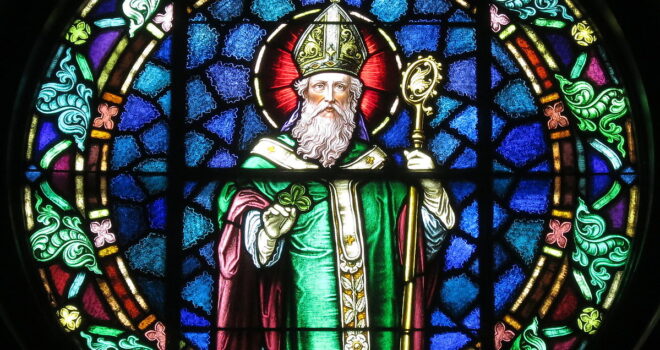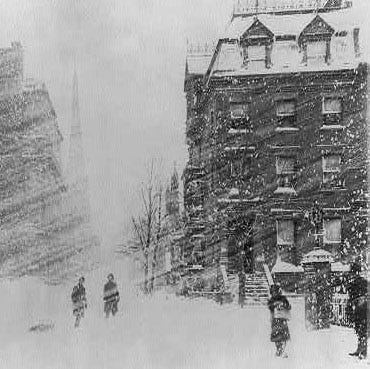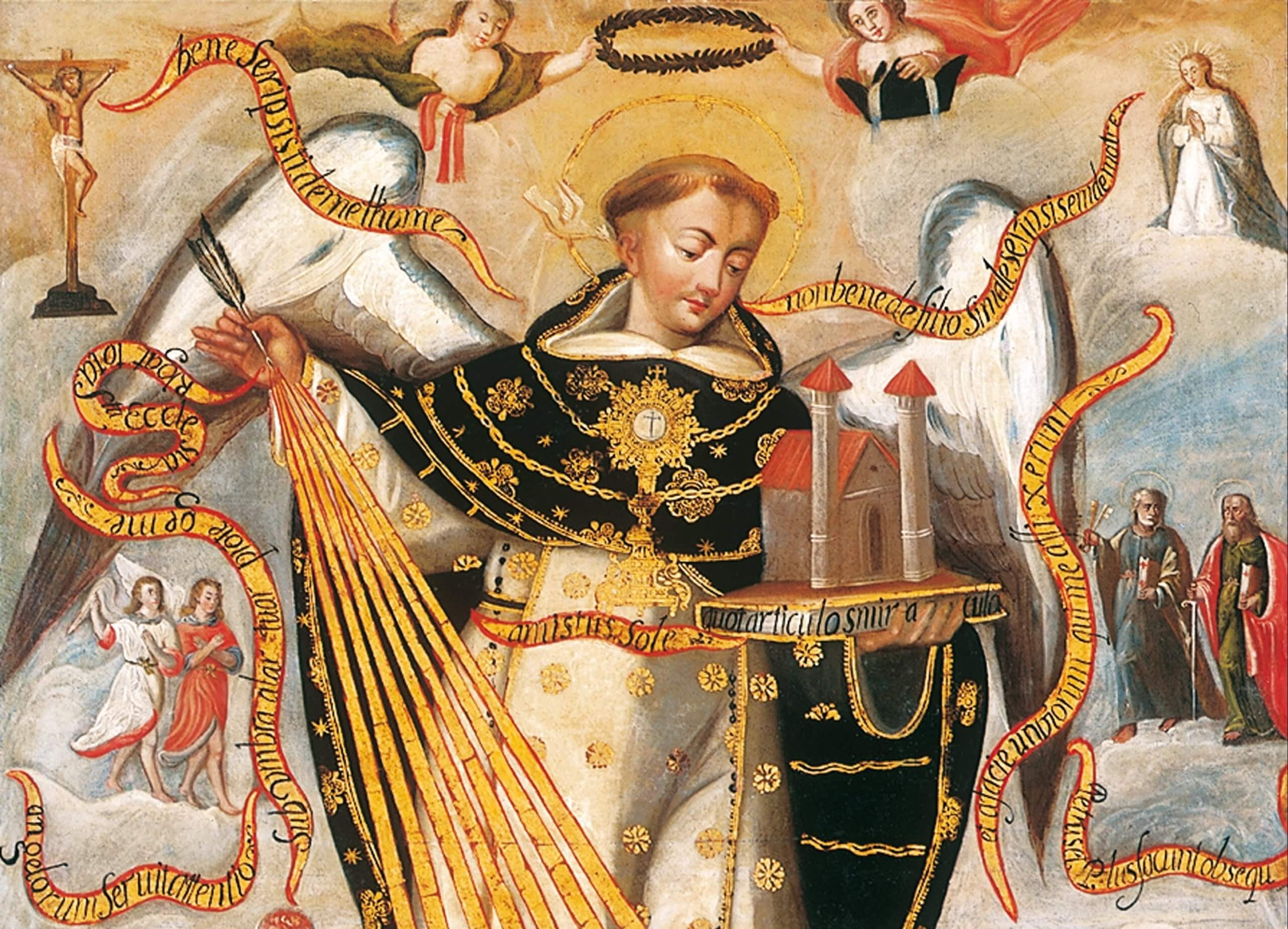The Bachall Isu—The Crozier of St. Patrick
Of all the relics bequeathed to us by Ireland’s catalogue of saints, the greatest was undoubtedly the episcopal crozier used by St. Patrick known as the Bachall Isu. The Irish word Bachall comes from the Latin baculus, a crozier or staff; Isu is a shortened form of the Latin name for our Lord, Iesus. Bachall […]



Of all the relics bequeathed to us by Ireland’s catalogue of saints, the greatest was undoubtedly the episcopal crozier used by St. Patrick known as the Bachall Isu. The Irish word Bachall comes from the Latin baculus, a crozier or staff; Isu is a shortened form of the Latin name for our Lord, Iesus. Bachall Isu thus means “Staff of Jesus,” a name reflecting a popular tradition that the staff was given to St. Patrick by Jesus Christ Himself. According to the fourth book of the medieval Tripartite Life of St. Patrick, when Patrick was in Italy preparing for his Irish mission, he traveled to an island in the Tyrrhenian Sea where he encountered a strange prodigy—a young man and and his wife with an elderly woman. The young man told Patrick that the old woman was one of his descendants. Patrick, mystified at how a young man could have an elderly descendant, asked how such a thing could be. He was told:
We have been here since the time of Christ. He came to visit us when He was on earth amongst men; and we made a feast for Him, and he blessed our house and blessed ourselves, though this blessing did not descend to our children. Thus we shall be here without age or decay forever.[1]
The young man recounted that Jesus Christ had told them that one day Patrick would visit the island. He accordingly had left a gift behind for the saint:
And it is long since thy coming was foretold to us, and God prophesied unto us that thou would come to preach to the Gael; and He left a token with us, i.e., His bachall (crozier), to be given to thee.[2]
Patrick was unsure of this story and told the man that if Jesus wished him to receive this bachall, He would have to deliver it to him Himself. Our Lord obliged:
Patrick remained three days and three nights with them; and he went afterwards into Sliabh-Hermoin, near the island, where the Lord appeared unto him, and commanded him to go and preach to the Gael; and He gave him the Bachall Isu and said that it would be of assistance to him in every danger and every difficulty in which he would find himself.[3]
St. Patrick came cherished this crozier. He asked his traveling companion, the goldsmith St. Tassach, to construct a special case for the relic. The case was not a box, but more of a form-fitting covering that allowed Patrick to keep the relic enclosed while still making use of it. The case would become an integral part of the relic; in later years, the staff itself was never removed from its protective covering.
The staff shows up a few other times in the ministry of Patrick. He would use the Bachall Isu when he famously overturned the idol of Crom Cruach, as narrated in the Tripartite Life—Patrick laid the crozier on the idol, which tipped over at contact with the holy staff. The Tripartite Life says that the idol was marred with an imprint where touched by Patrick’s crozier.[4]
The Bachall Isu also played a prominent role in the baptism ceremony of Óengus mac Nad Froích, King of Munster and the first Irish king to adopt Christianity. Patrick was greeted by King Óengus in 445 while passing through Munster. King Óengus already had some knowledge of Christianity and wished to be baptized by Patrick. St. Patrick agreed, and plans were laid for the ceremony at the royal seat of Cashel. On the day of his baptism, Óengus was presented before Patrick with his royal entourage. St. Patrick was vested in full episcopal regalia carrying the Bachall Isu, at the end of which was a sharp iron spike, by means of which Patrick could plant the crozier in the ground when preaching. During the baptism, St. Patrick inadvertently thrust the spike through the king’s foot, transfixing him to the earth. Óengus grimaced, but neither moved nor complained. It was not until the ceremony was concluded that Patrick realized what had happened. The saint apologized profusely but asked King Óengus why he did not speak up. Óengus replied that he thought it was part of the ritual.
The Bachall Isu became a powerful symbol of the authority of the See of Armagh. It was used as a witness to oaths; rival chieftains often swore peace treaties before it. Those who lied in its presence or swore falsely upon it were believed to invite plagues upon themselves.[5] Patrick’s successors would beautify St. Tassach’s case with precious jewels, highlighting its importance as a symbol of episcopal jurisdiction. The hereditary custody of the Bachall Isu was entrusted to the lay administrators of the archdiocese, the Ui Sinaich, descendants of Daire, King of Airgíalla, who had donated the hill of Ard Mhacha (Armagh) to Patrick. The Ui Sinaich were jealous of the relic, allowing or withholding access to it as a point of leverage with the archbishops of Armagh.
When the reforming bishop St. Malachy was made archbishop of Armagh in 1132, the Ui Sinaich made off with the Bachall Isu, preventing Malachy from taking possession of it. As laymen, the Ui Sinaich were threatened by St. Malachy, who had pledged to break the power of laymen over the See of Armagh. Since this staff was the symbol of Armagh’s authority, Malachy could not govern effectively without it. For five years Malachy tried without success to persuade the Ui Sinaich to return the relic; it was only when Malachy gave them three sacks of gold that the Ui Sinaich finally yielded the Bachall to him.
St. Malachy was a friend of St. Bernard and spent time in Clairvaux, where Bernard had the opportunity to see the Bachall Isu and described it in his writings. Bernard said:
And the staff covered with gold and adorned with the most costly gems, which they call the ‘Staff of Jesus,’ because the staff itself—as report affirms—held it in His hands and fashioned it, was deemed of the highest honor and sanctity in that nation [Ireland].[6]
Shortly after St. Malachy’s death, the Synod of Kells elevated Dublin to an archbishopric, placing it on equal footing with Armagh. Conflicts among the Ulster chieftains made Armagh an unsafe place for the relic, so Archbishop Gilla of Armagh sent the Bachall to the town of Ballibaghill (modern Ballyboughal), in the region of Dublin. Ballibaghill had hosted the Bachall Isu before on the occasion of a treaty between the lords of Munster and Ulster and was well-suited to protect the relic (in fact, the word Ballibaghill means “Town of the Bachall,”—Baile Bachaill). The staff was thus installed in Ballybaghill. But shortly thereafter, the Norman lord Richard de Clare—better known as Richard Strongbow—conquered Ballibaghill, beheaded its Gaelic chieftain, and permanently entrusted the Bachall to the care of Holy Trinity cathedral of Dublin. An entry recording this event is found in the Repertorium Viride, a 16th century chronicle of the history of Dublin. The Repertorium records for the year 1172:
Count Richard decapitated McGoghdane in Fingal, and with the consent of Robert Fitz-Stephen, and granted this place [Ballybaghill] to the Cathedral Church of Holy Trinity, along with the Baculus Jesu, which is called the Baculus of St. Patrick.[7]
Thus from the 12th century on the Bachall was kept in Dublin, despite being the symbol of the Primacy of Armagh. When not in use for ecclesiastical or state occasions, it was kept in repose as an object of veneration. Holy Trinity was one of the chief places of pilgrimage in Ireland in the Middle Ages and the Bachall was one of the most popular relics venerated by medieval Irish pilgrims. A papal edict of 1477 mentions Holy Trinity as one of the churches in Ireland granted certain indulgences for visits of the faithful to its sacred relics, most notably the Bachall Isu.[8]
The relic continued to be used as a witness in oaths into the 16th century. One notable example comes from 1529 during the reign of Henry VIII. Henry’s agents in Dublin brought a treason case against a certain knight, one Gerald MacShayne. The specifics of MacShayne’s crimes have been lost to history, but the record of the proceedings reveal this was a solemn occasion, attended by the king’s deputies, chancellor, treasurer, and court justices. When MacShayne testified on May 29, 1529, the record says he swore “upon the Holie Maseboke [the Gospels]” and also upon “the great relicke of Erlonde [Ireland], called Baculum Christi.” [9]
The trial of MacShayne offers the last mention of the Bachall Isu before it was lost to history. Its end came a decade later, in 1539. By then Ireland was in the grips of the Protestant Reformation, which was foisted upon it by the decrees of King Henry VIII. Henry had set up a royally controlled “Church of Ireland” to parallel his new Anglican Church. Henry entrusted the Church of Ireland to the Archbishop of Dublin, George Browne, whom he named Primate of Ireland. Browne, a former Augustinian monk, was a zealous believer in the royal supremacy who used his position to impose the Reformation on the churches under his control. He closed monasteries and had his servants strike the pope’s name from all the liturgical books. Even more strikingly, Browne assembled the vast and ancient collection of relics housed in the cathedral in Dublin, gathered them into a heap, and lit them on fire. One of the relics tragically lost in this inferno was the Bachall Isu. Despite its rich history stretching back a thousand years, George Browne considered it a superstitious relic. He seized the staff—and after prying all the gems and precious metals from it—had it burned in Skinner’s Row outside Christ Church Cathedral in Dublin. One redeeming facet of this story is that George Browne was later reconciled with the Catholic Church during the reign of Queen Mary, was received back into the clergy by Cardinal Pole, and died in communion with the Church.
Thus ends our study of the Bachall Isu, this most precious relic of the Irish Church. If you’d like to learn more about the history of Ireland, may I humbly recommend by book The Saga of Ireland: A Concise History of the Emerald Isle. The Saga of Ireland brings the stirring history of Erin to life in thrilling clarity. Interwoven with engaging historical fiction vignettes and peppered throughout with beautiful illustrations, The Saga of Ireland offers an engaging journey through two millennia of Irish history.
[1] Tripartite Life of St. Patrick, Book IV, Cap. I
[2] Ibid.
[3] Ibid.
[4] Tripartite Life, Book IV, Cap. II
[5] Miles V. Miles, “St. Patrick’s Staff and Christ Church,” Dublin Historical Record 5.4 (Jun-Aug 1943): 122.
[6] Bernard of Clairvaux, Life of St. Malachy, 4:24
[7] John Alen, Repertorium Viride, 86
[8] Miles, 127
[9] Miles, 128
Image via Wikimedia Commons.














